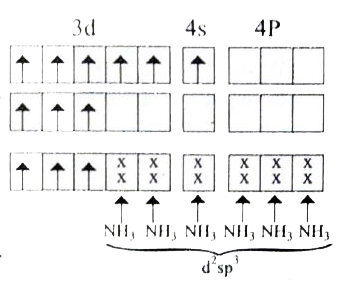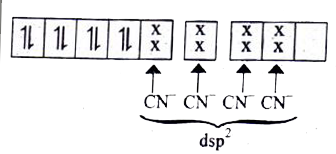Based VB theory explain why is paramagnetic , while is diamagnetic. Solution in Tamil
(a)
In this complex Cr is in the +3 oxidation state.
Electronic configuration of Cr atom
Electronic configuration of ion
Hybridisation and formation of complex
* Due to the presence of three unpaired electrons in it behaves as a paramagnetic substance
* The spin magnetic moment,
* is an inner orbital octahedral complex.

(b)
In this complex Ni is the +2 oxidation state.
Electronic configuration of Ni atom
Electronic configuration of ion

Hybridisation and formation of Complex

Since is strong field ligand, hence the electrons in 3d orbitals for forced to pair up and there is no unpaired electron in , hence it should be diamagnetic substance.
Topper's Solved these Questions
- SAMPLE PAPER 10 (SOLVED)Book:FULL MARKSChapter:SAMPLE PAPER 10 (SOLVED)Exercise:Part-IV
Explore 10 Videos
- SAMPLE PAPER 10 (SOLVED)Book:FULL MARKSChapter:SAMPLE PAPER 10 (SOLVED)Exercise:Part-II
Explore 9 Videos
- SAMPLE PAPER - 9 (SOLVED)Book:FULL MARKSChapter:SAMPLE PAPER - 9 (SOLVED)Exercise:PART-IV
Explore 10 Videos
- SAMPLE PAPER 2 (SOLVED)Book:FULL MARKSChapter:SAMPLE PAPER 2 (SOLVED)Exercise:PART IV
Explore 5 Videos
Similar Questions
(a) (i) What is Cementation?
(ii) Write a notes on ionisation enthalpy in p-block elements?
View SolutionPredict the conditions under which
(a) Aluminium might be expected to reduce magnesia.
(b) Magnesium could reduce alumina.
View Solution(i) CO is more stable at higher temperature. Why ?
(ii) How will you prepare potash alum ?
View Solution(a) (i) Describle a method for refining nickel.
(ii) Why group 18 elements are called inert gases ? Write the general electronic configuration of group 18 elements.
(b) (i) Give the uses of helium.
(ii) Ni(II) compounds are more stable than Pt(II) compound.Give reason.
View Solution[Cr(NH3)6]3+ is paramagnetic while [Ni(CN)4]2− is diamagnetic. Explain why?
View Solution[Ni(CN)_(4)]^(2-) is diamagnetic while [Cr(NH_(3))_(6)]^(3+) is paramagnetic. Explain.
View Solution[Cr(NH3)6]3+ is paramagnetic while [Ni(CN)4)]2− is diamagnetic Why ?
View Solution[Cr(NH_(3))_(6)]^(3+) is paramagnetic while [Ni(CN)_(4)]^(2-) is diamagnetic. Explain why ?
View SolutionBased VB theory explain why [Cr(NH3)6]3+ is paramagnetic , while [Ni(CN4)2− is diamagnetic.
View Solution[Co(NH_3)_6]^(3+) is diamagnetic where as [CoF_6]^(3-) is paramagnetic explain.
View Solution[Cr(NH_(3))_(6)]^(3+) is paramagnetic while [Ni(CN)_(4)]^(2-) is diamagnetic. Explain why?
View SolutionBased on VB theory explain why [Cr(NH_(3))_(6)]^(3+) is paramagnetic, while [Ni(CN)_(4)]^(2-) is diamagnetic.
View Solution[Cr(NH3)6]3+ is paramagnetic while [Ni(CN)4]2− is diamagnetic . Explain why?
View Solution[Cr(NH3)6]3+ is paramagnetic while [Ni(CN)4]2− is diamagnetic. Explain, why ?
View Solution[Cr(NH3)6]3+ is paramagnetic while [Ni(CN)4]2− is diamagnetic. Explain why?
View Solution
